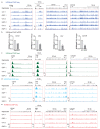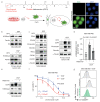CD44 regulates epigenetic plasticity by mediating iron endocytosis
- PMID: 32747755
- PMCID: PMC7612580
- DOI: 10.1038/s41557-020-0513-5
CD44 regulates epigenetic plasticity by mediating iron endocytosis
Abstract
CD44 is a transmembrane glycoprotein linked to various biological processes reliant on epigenetic plasticity, which include development, inflammation, immune responses, wound healing and cancer progression. Although it is often referred to as a cell surface marker, the functional regulatory roles of CD44 remain elusive. Here we report the discovery that CD44 mediates the endocytosis of iron-bound hyaluronates in tumorigenic cell lines, primary cancer cells and tumours. This glycan-mediated iron endocytosis mechanism is enhanced during epithelial-mesenchymal transitions, in which iron operates as a metal catalyst to demethylate repressive histone marks that govern the expression of mesenchymal genes. CD44 itself is transcriptionally regulated by nuclear iron through a positive feedback loop, which is in contrast to the negative regulation of the transferrin receptor by excess iron. Finally, we show that epigenetic plasticity can be altered by interfering with iron homeostasis using small molecules. This study reveals an alternative iron-uptake mechanism that prevails in the mesenchymal state of cells, which illuminates a central role of iron as a rate-limiting regulator of epigenetic plasticity.
Conflict of interest statement
The authors declare no competing interests.
Figures












References
-
- Ponta H, Sherman L, Herrlich PA. CD44: from adhesion molecules to signalling regulators. Nat Rev Mol Cell Biol. 2003;4:33–45. - PubMed
-
- Zöller M. CD44: can a cancer-initiating cell profit from an abundantly expressed molecule? Nat Rev Cancer. 2011;11:254–267. - PubMed
-
- Nieto MA, Huang RY, Jackson RA, Thiery JP. EMT: 2016. Cell. 2016;166:21–45. - PubMed
-
- Brabletz T, Kalluri R, Nieto MA, Weinberg RA. EMT in cancer. Nat Rev Cancer. 2018;18:128134 - PubMed
-
- Pastushenko I, et al. Identification of the tumour transition states occurring during EMT. Nature. 2018;556:463–468. - PubMed
Publication types
MeSH terms
Substances
Grants and funding
LinkOut - more resources
Full Text Sources
Other Literature Sources
Medical
Molecular Biology Databases
Miscellaneous

